The Microstructure Evolution and Mechanical Properties of Rotary Friction Welded Duplex Stainless Steel Pipe
Abstract
:1. Introduction
2. Material and Methods
2.1. Materials
2.2. Determination of Processing Parameters
2.3. Characterization Method
3. Results and Discussion
3.1. Microstructure Evolution
3.2. Mechanical Properties
3.2.1. Tensile Test
3.2.2. Vickers Hardness
4. Conclusions
- The sound joints, free of cracks and pores, are obtained for the 2205 duplex stainless alloy using rotating friction welding with the following parameters: a rotating speed of 20 m/s, friction pressure of 10 MPa, friction time of 30 s, and forging pressure of 30 MPa.
- The microstructure of the weld zone is composed of ferrite and austenite phases, with no deleterious phase. The ferrite of the base metal, TMAZ, and weld is 53.3%, 54.5%, and 68.7%, respectively. The weld zone has no harmful phase due to the fast cooling after rotary friction welding.
- The ferrite/austenite grains are significantly refined under the thermomechanical effect. In the TMAZ1, the ferrite/austenite grain size is 0.22 μm and 0.24 μm, respectively. In the TMAZ2, the ferrite/austenite grain size is 0.64 μm and 0.47 μm, respectively. In the weld, the ferrite/austenite grain size is 0.40 μm and 0.41 μm, respectively. The ultrafine grain DSS weld joint is obtained by rotary friction welding.
- There are more LAGBs in the weld zone, TMAZ1, and TMAZ2 than the base metal. The generation of LAGB mostly comes from the dynamic recovery (DRV) that occurs within a grain. Due to the high heating and cooling rate and the short welding time of the RFW, there is not enough time for sufficient dynamic recrystallization of the microstructure in the weld zone.
- Due to a slight increase in the ferrite content in the weld zone, grain refinement, and an increase in dislocation density, the hardness of the weld zone increases to 358 HV0.2 compared with that of the base material, which is about 300 HV0.2, and the strength of the joints is nearly the same as that of the base material.
Author Contributions
Funding
Institutional Review Board Statement
Informed Consent Statement
Data Availability Statement
Acknowledgments
Conflicts of Interest
References
- Verma, J.; Taiwade, R.V. Effect of welding processes and conditions on the microstructure, mechanical properties and corrosion resistance of duplex stainless steel weldments—A review. J. Manuf. Process. 2017, 25, 134–152. [Google Scholar] [CrossRef]
- Azevedo, C.R.D.F.; Pereira, H.B.; Wolynec, S.; Padilha, A.F. An overview of the recurrent failures of duplex stainless steels. Eng. Fail. Anal. 2019, 97, 161–188. [Google Scholar] [CrossRef]
- Ma, Y.-Y.; Yan, S.; Yang, Z.-G.; Qi, G.-S.; He, X.-Y. Failure analysis on circulating water pump of duplex stainless steel in 1000MW ultra-supercritical thermal power unit. Eng. Fail. Anal. 2015, 47, 162–177. [Google Scholar] [CrossRef]
- Zhang, S. Failure analysis on tee pipe of duplex stainless in an oilfield. Eng. Fail. Anal. 2020, 115, 104676. [Google Scholar] [CrossRef]
- Tian, J.; Wang, L.; Sun, W.; Yang, Y.; Liu, Z.; Wang, G.; Zhao, L.; Zhou, Y.; Liu, G. Failure analysis of steam jet pump at top of crude oil vacuum distillation tower. Eng. Fail. Anal. 2019, 103, 9–19. [Google Scholar] [CrossRef]
- Putz, A.; Hosseini, V.A.; Westin, E.M.; Enzinger, N. Microstructure investigation of duplex stainless steel welds using arc heat treatment technique. Weld. World 2020, 64, 1135–1147. [Google Scholar] [CrossRef]
- Li, F.; Liu, Y.; Ke, W.; Jin, P.; Kong, H.; Chen, M.; Sun, Q. A novel pathway to weld forming control and microstructure improvement of duplex stainless steel via alternating magnetic field. J. Manuf. Process. 2022, 80, 581–590. [Google Scholar] [CrossRef]
- Chaudhari, A.N.; Dixit, K.; Bhatia, G.S.; Singh, B.; Singhal, P.; Saxena, K.K. Welding Behaviour of Duplex Stainless Steel AISI 2205: AReview. Mater. Today Proc. 2019, 18, 2731–2737. [Google Scholar] [CrossRef]
- Makhdoom, M.A.; Ahmad, A.; Kamran, M.; Abid, K.; Haider, W. Microstructural and electrochemical behavior of 2205 duplex stainless steel weldments. Surf. Interfaces 2017, 9, 189–195. [Google Scholar] [CrossRef]
- Tasalloti, H.; Kah, P.; Martikainen, J. Effect of heat input on dissimilar welds of ultra high strength steel and duplex stainless steel: Microstructural and compositional analysis. Mater. Charact. 2017, 123, 29–41. [Google Scholar] [CrossRef]
- Sieurin, H.; Sandström, R. Fracture toughness of a welded duplex stainless steel. Eng. Fract. Mech. 2006, 73, 377–390. [Google Scholar] [CrossRef]
- Nowacki, J.; Rybicki, P. The influence of welding heat input on submerged arc welded duplex steel joints imperfections. J. Mater. Process. Technol. 2005, 164–165, 1082–1088. [Google Scholar] [CrossRef]
- Sieurin, H.; Sandström, R. Austenite reformation in the heat-affected zone of duplex stainless steel 2205. Mater. Sci. Eng. A 2006, 418, 250–256. [Google Scholar] [CrossRef]
- Ramkumar, K.D.; Mishra, D.; Vignesh, M.; Raj, B.G.; Arivazhagan, N.; Naren, S.V.; Kumar, S.S. Metallurgical and mechanical characterization of electron beam welded super-duplex stainless steel UNS 32750. J. Manuf. Process. 2014, 16, 527–534. [Google Scholar] [CrossRef]
- Singh, J.; Shahi, A. Metallurgical, impact and fatigue performance of electron beam welded duplex stainless steel joints. J. Mater. Process. Technol. 2019, 272, 137–148. [Google Scholar] [CrossRef]
- Wang, Q.; Gu, G.; Jia, C.; Li, K.; Wu, C. Investigation of microstructure evolution, mechanical and corrosion properties of SAF 2507 super duplex stainless steel joints by keyhole plasma arc welding. J. Mater. Res. Technol. 2023, 22, 355–374. [Google Scholar] [CrossRef]
- Selvabharathi, R.; Muralikannan, R. Influence of shot peening and plasma ion nitriding on tensile strength of 2205 duplex stainless steel using A-PAW. Mater. Sci. Eng. A 2018, 709, 232–240. [Google Scholar] [CrossRef]
- Kumar, P.; Hodgson, P.; Beladi, H.; Makhatha, M.E.; Dutt, A.K. EBSD Investigation to Study the Restoration Mechanism and Substructural Characteristics of 23Cr–6Ni–3Mo Duplex Stainless Steel During Post-deformation Annealing. Trans. Indian Inst. Met. 2020, 73, 1421–1431. [Google Scholar] [CrossRef]
- Li, L.; Du, Z.; Sheng, X.; Zhao, M.; Song, L.; Han, B.; Li, X. Comparative analysis of GTAW+SMAW and GTAW welded joints of duplex stainless steel 2205 pipe. Int. J. Press. Vessel. Pip. 2022, 199, 104748. [Google Scholar] [CrossRef]
- Zhang, Z.; Jing, H.; Xu, L.; Han, Y.; Zhao, L.; Lv, X. Effect of post-weld heat treatment on microstructure evolution and pitting corrosion resistance of electron beam-welded duplex stainless steel. Corros. Sci. 2018, 141, 30–45. [Google Scholar] [CrossRef]
- Taysom, B.S.; Sorensen, C.D. Controlling martensite and pearlite formation with cooling rate and temperature control in rotary friction welding. Int. J. Mach. Tools Manuf. 2019, 150, 103512. [Google Scholar] [CrossRef]
- Pissanti, D.R.; Scheid, A.; Kanan, L.F.; Dalpiaz, G.; Kwietniewski, C.E.F. Pipeline girth friction welding of the UNS S32205 duplex stainless steel. Mater. Des. 2018, 162, 198–209. [Google Scholar] [CrossRef]
- Chludzinski, M.; dos Santos, R.E.; Pissanti, D.R.; Kroeff, F.C.; Mattei, F.; Dalpiaz, G.; Paes, M.T.P. Full-scale friction welding system for pipeline steels. J. Mater. Res. Technol. 2019, 8, 1773–1780. [Google Scholar] [CrossRef]
- Li, W.-Y.; Ma, T.; Yang, S.; Xu, Q.; Zhang, Y.; Li, J.; Liao, H. Effect of friction time on flash shape and axial shortening of linear friction welded 45 steel. Mater. Lett. 2008, 62, 293–296. [Google Scholar] [CrossRef]
- McAndrew, A.R.; Colegrove, P.A.; Bühr, C.; Flipo, B.C.; Vairis, A. A literature review of Ti-6Al-4V linear friction welding. Prog. Mater. Sci. 2018, 92, 225–257. [Google Scholar] [CrossRef]
- Li, W.; Suo, J.; Ma, T.; Feng, Y.; Kim, K. Abnormal microstructure in the weld zone of linear friction welded Ti–6.5Al–3.5Mo–1.5Zr–0.3Si titanium alloy joint and its influence on joint properties. Mater. Sci. Eng. A 2014, 599, 38–45. [Google Scholar] [CrossRef]
- Wu, T.-H.; Wang, J.-J.; Li, H.-B.; Jiang, Z.-H.; Liu, C.-M.; Zhang, H.-Y. Effect of heat input on austenite microstructural evolution of simulated heat affected zone in 2205 duplex stainless steel. J. Iron Steel Res. Int. 2019, 26, 435–441. [Google Scholar] [CrossRef]
- Banerjee, A.; Ntovas, M.; Da Silva, L.; Rahimi, S.; Wynne, B. Inter-relationship between microstructure evolution and mechanical properties in inertia friction welded 8630 low-alloy steel. Arch. Civ. Mech. Eng. 2021, 21, 149. [Google Scholar] [CrossRef]
- Marques, I.J.; Da Silva, F.J.; Santos, T.F. Rapid precipitation of intermetallic phases during isothermal treatment of duplex stainless steel joints produced by friction stir welding. J. Alloy. Compd. 2020, 820, 153170. [Google Scholar] [CrossRef]
- Cao, F.; Sun, T.; Hu, J.; Hou, W.; Huang, G.; Shen, Y.; Ma, N.; Geng, P.; Hu, W.; Qu, X. Enhanced mechanical and anticorrosion properties in cryogenic friction stir processed duplex stainless steel. Mater. Des. 2022, 225, 111492. [Google Scholar] [CrossRef]
- Cao, F.; Huang, G.; Hou, W.; Ni, R.; Sun, T.; Hu, J.; Shen, Y.; Gerlich, A.P. Simultaneously enhanced strength-ductility synergy and corrosion resistance in submerged friction stir welded super duplex stainless steel joint via creating ultrafine microstructure. J. Mater. Process. Technol. 2022, 307, 117660. [Google Scholar] [CrossRef]
- Hitchcock, G.; Deans, W.; Thompson, D.; Coats, A. Pin-hole and crack formation in a duplex stainless steel downhole tool. Eng. Fail. Anal. 2001, 8, 213–226. [Google Scholar] [CrossRef]

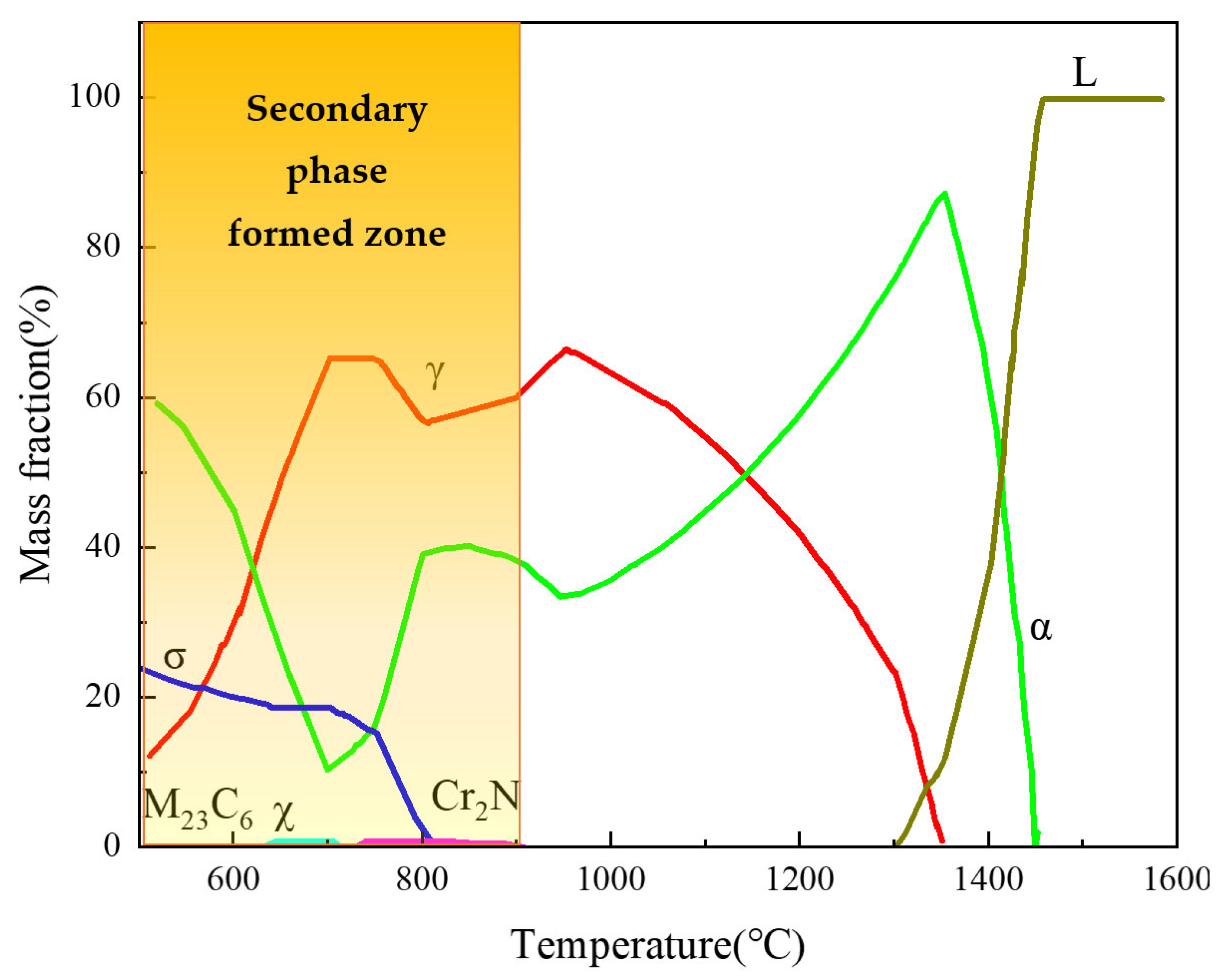

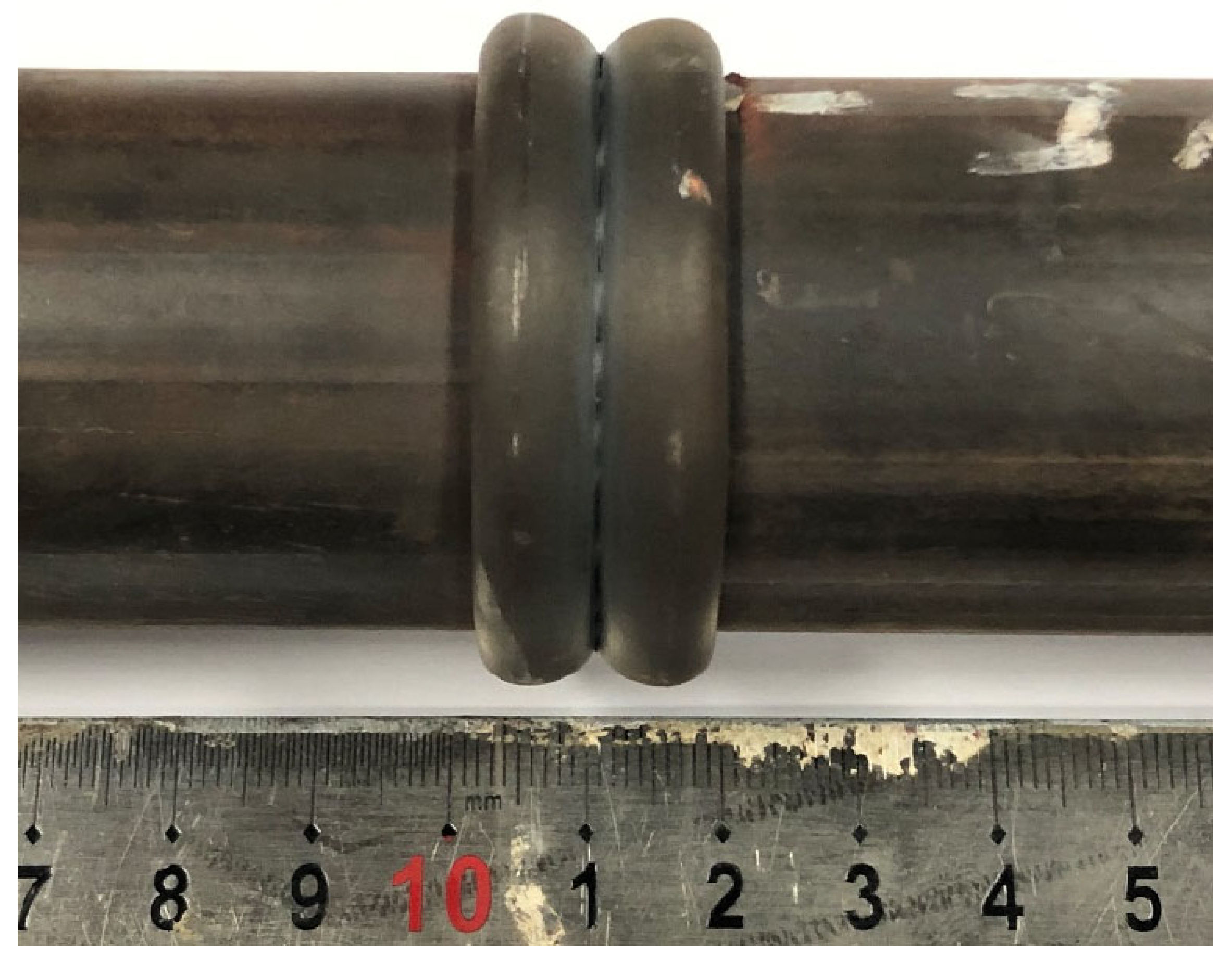
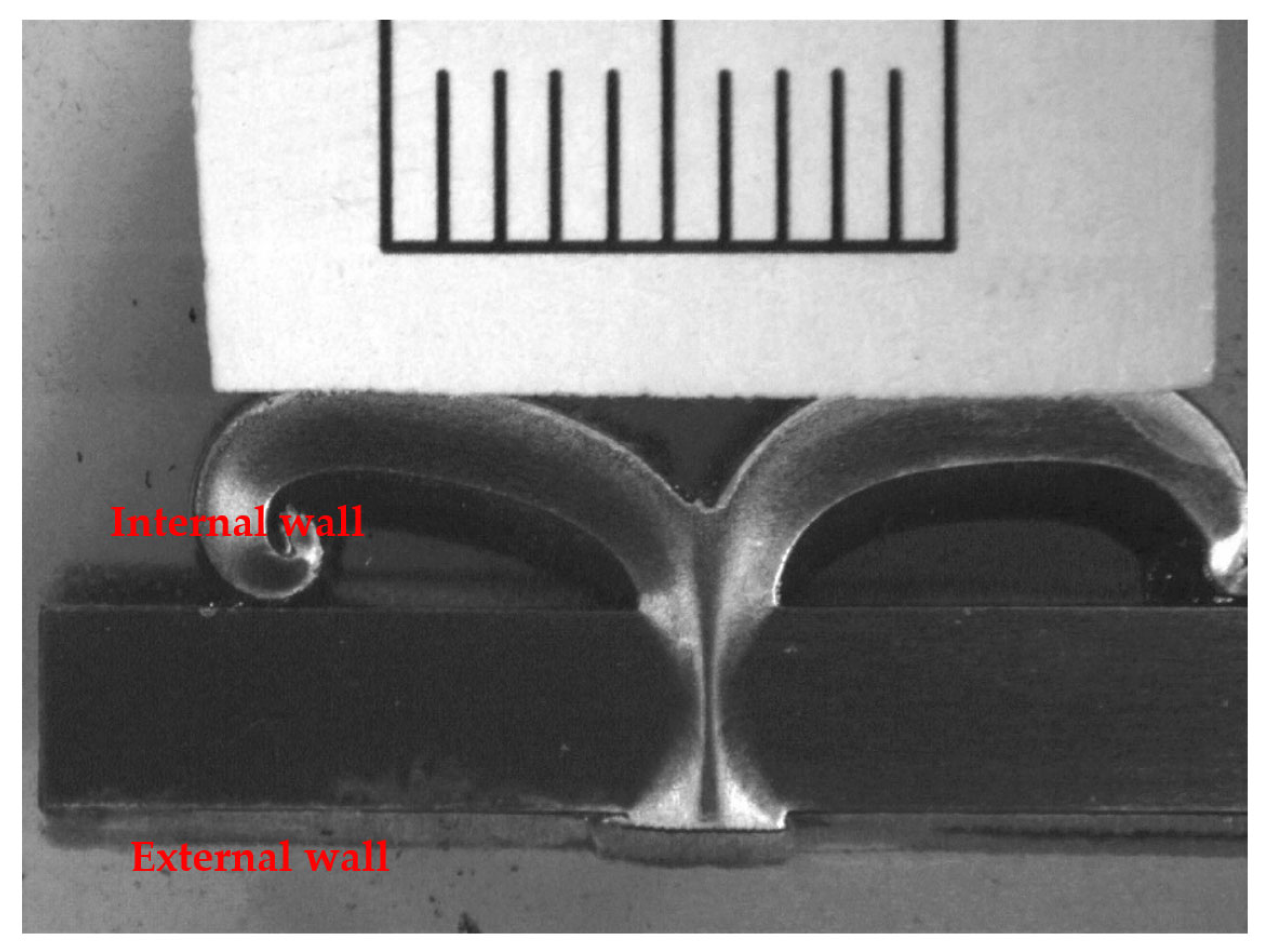
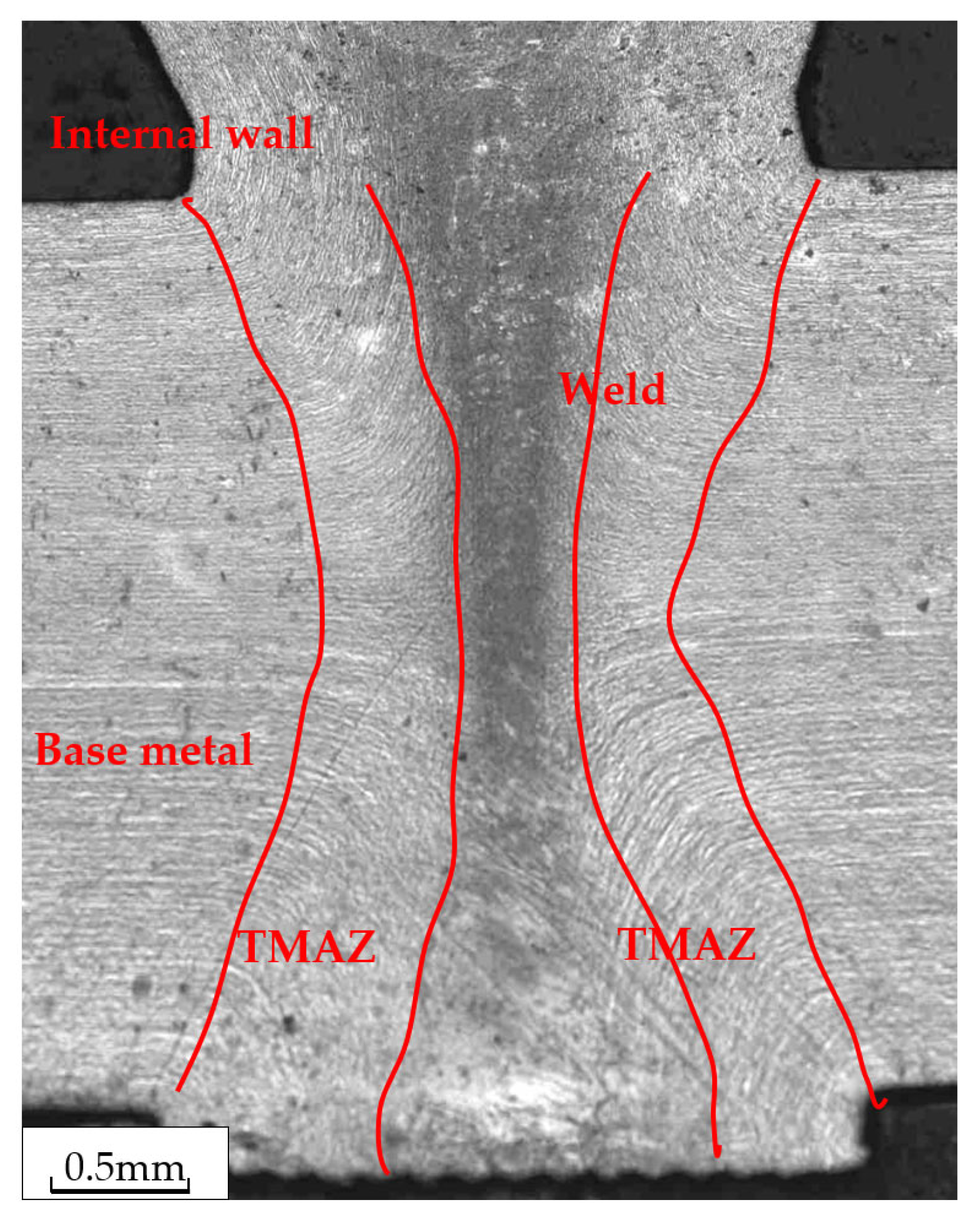
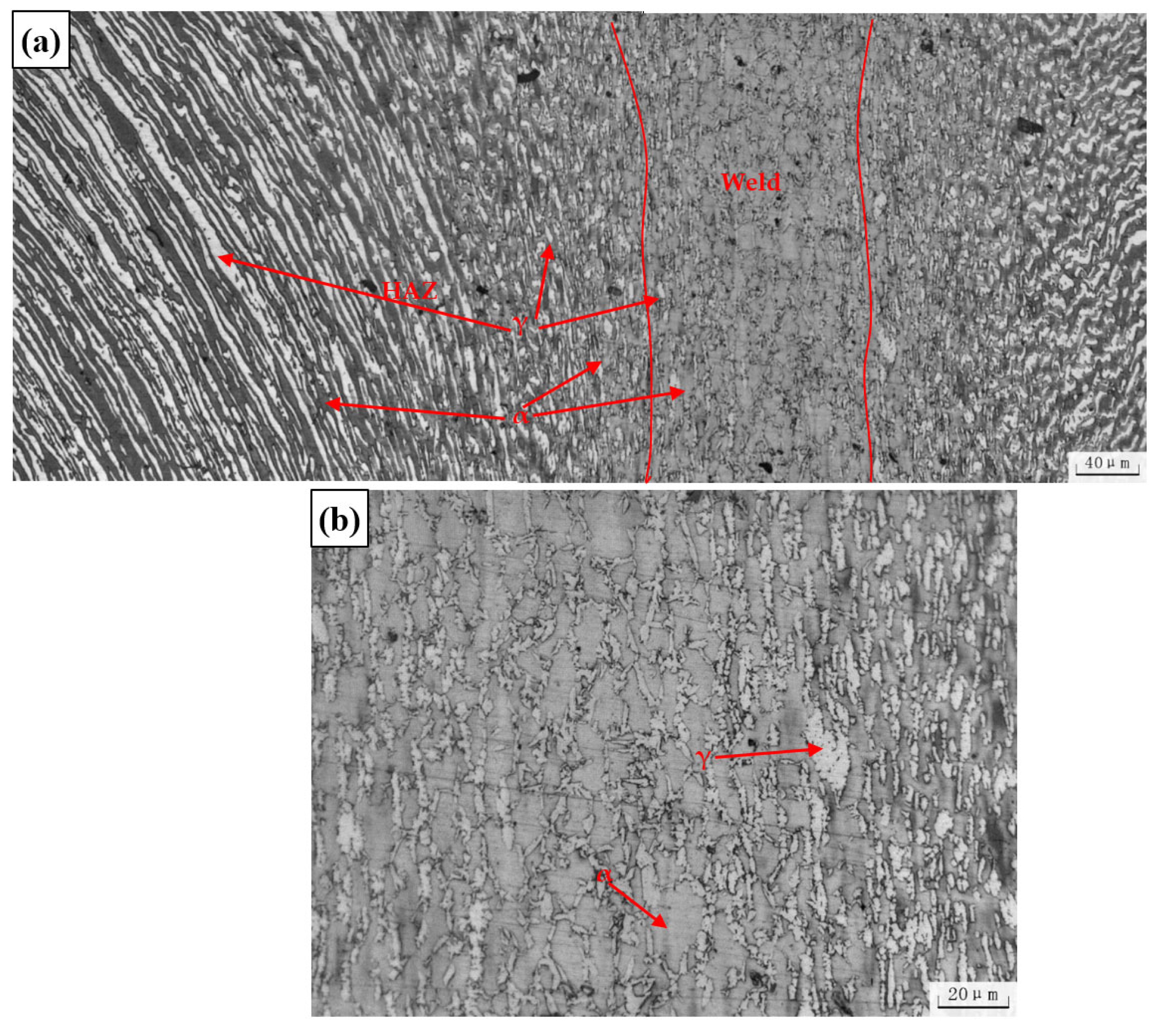
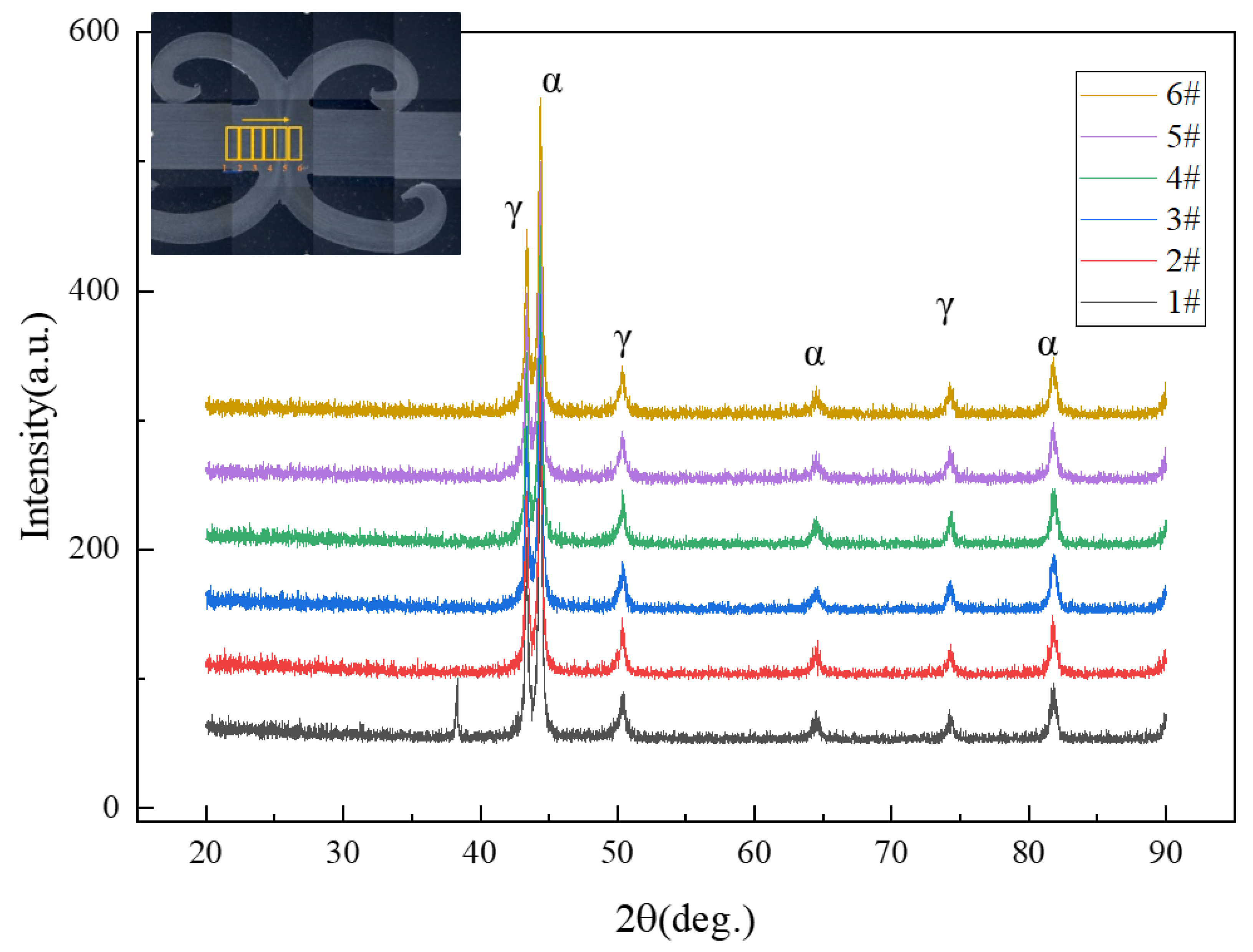
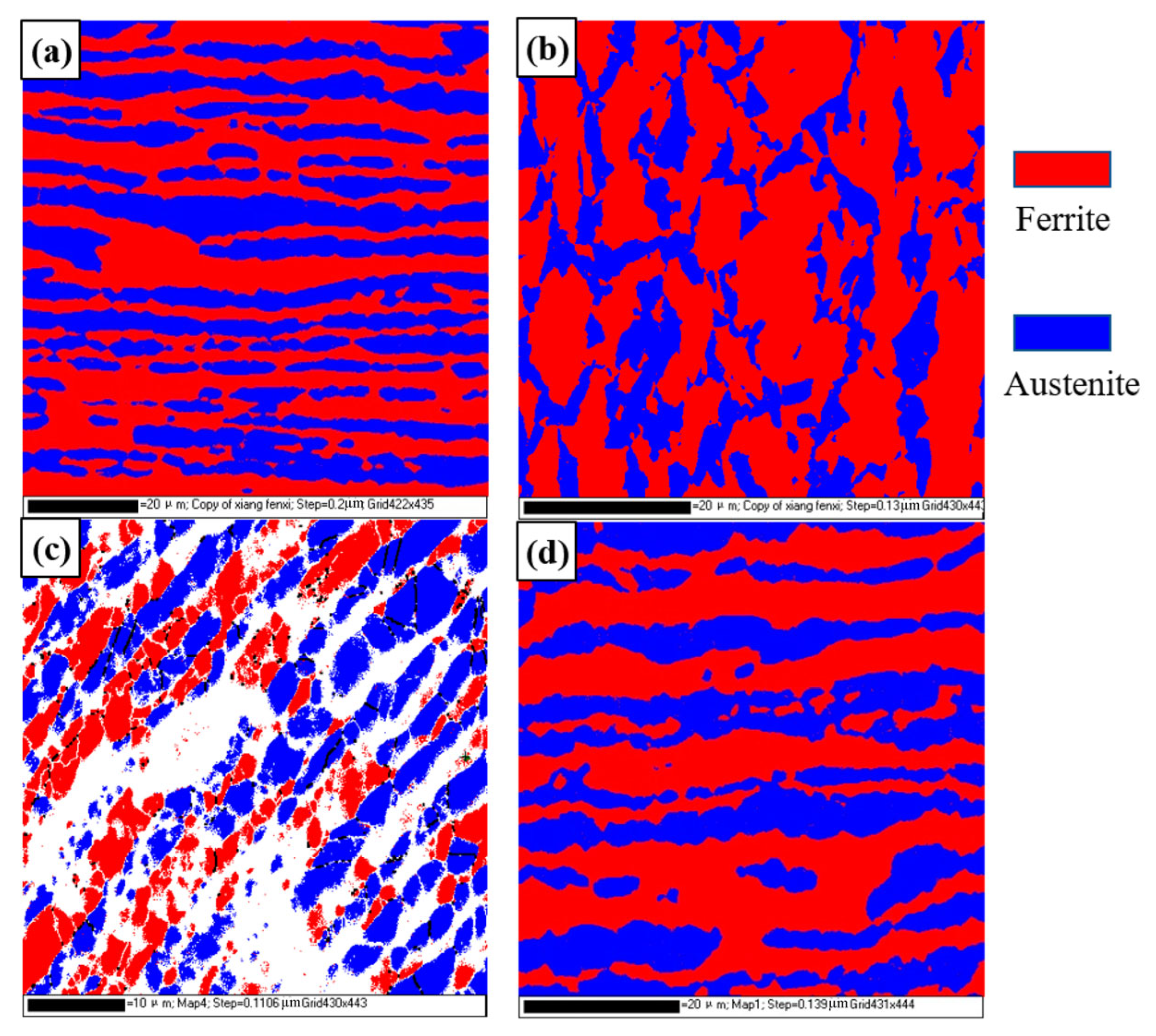





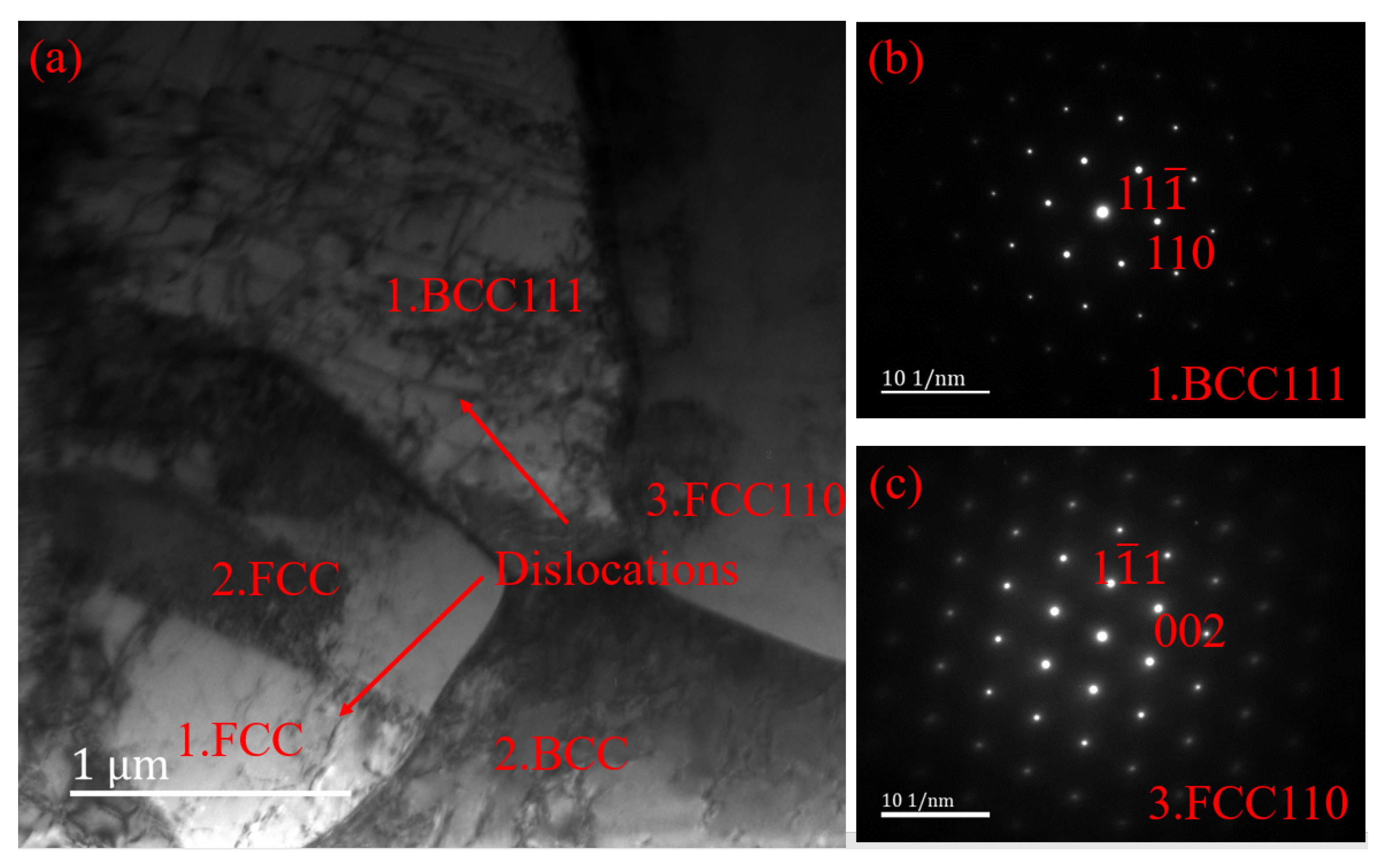


| Element | C | Si | Mn | P | S | Cr | Ni | Mo | N |
|---|---|---|---|---|---|---|---|---|---|
| Content | 0.018 | 0.53 | 1.52 | 0.025 | 0.0007 | 21.57 | 5.58 | 2.96 | 0.17 |
| ISO 13680-2010 | ≤0.03 | ≤1.0 | ≤2.0 | ≤0.03 | ≤0.02 | 21.0~23.0 | 4.5~6.5 | 2.50~3.50 | 0.08~0.20 |
| Content (%) | Average Grain Size (μm) | |||
|---|---|---|---|---|
| Ferrite-bcc | Austenite-fcc | Ferrite-bcc | Austenite-fcc | |
| BM | 53.3% | 46.7% | 0.746 | 1.156 |
| Weld | 68.7% | 31.3% | 0.404 | 0.408 |
| TMAZ1 | 23.3% | 32.5% | 0.217 | 0.239 |
| TMAZ2 | 54.5% | 45.5% | 0.643 | 0.471 |
| Ferrite (%) | Austenite (%) | |||||
|---|---|---|---|---|---|---|
| Recrystallization | Substructured | Deformed | Recrystallization | Substructured | Deformed | |
| BM | 65.9 | 33.2 | 0.83 | 26.2 | 72.5 | 1.34 |
| Weld | 4.65 | 94.2 | 1.17 | 7.93 | 73.3 | 18.8 |
| TMAZ1 | 26.1 | 64.8 | 9.11 | 10.6 | 81.2 | 8.2 |
| TMAZ2 | 15.7 | 83.4 | 0.887 | 3.29 | 82 | 14.7 |
| Sample | Diameter/Width × Thickness × Gauge Length (mm × mm) | Yield Strength (0.5%EUL) (MPa) | Tensile Strength (MPa) | Elongation (%) |
|---|---|---|---|---|
| Base material | Φ38.1 × 3.2 × 50 | 603 | 817 | 38 |
| 602 | 819 | 38 | ||
| 594 | 814 | 38 | ||
| Welded joint | 5 × 3.2 × 25 | 590 | 811 | Failed at base pipe |
| 597 | 823 |
Disclaimer/Publisher’s Note: The statements, opinions and data contained in all publications are solely those of the individual author(s) and contributor(s) and not of MDPI and/or the editor(s). MDPI and/or the editor(s) disclaim responsibility for any injury to people or property resulting from any ideas, methods, instructions or products referred to in the content. |
© 2023 by the authors. Licensee MDPI, Basel, Switzerland. This article is an open access article distributed under the terms and conditions of the Creative Commons Attribution (CC BY) license (https://creativecommons.org/licenses/by/4.0/).
Share and Cite
Zhang, S.; Xie, F.; Wu, X.; Luo, J.; Li, W.; Yan, X. The Microstructure Evolution and Mechanical Properties of Rotary Friction Welded Duplex Stainless Steel Pipe. Materials 2023, 16, 3569. https://doi.org/10.3390/ma16093569
Zhang S, Xie F, Wu X, Luo J, Li W, Yan X. The Microstructure Evolution and Mechanical Properties of Rotary Friction Welded Duplex Stainless Steel Pipe. Materials. 2023; 16(9):3569. https://doi.org/10.3390/ma16093569
Chicago/Turabian StyleZhang, Shuxin, Faqin Xie, Xiangqing Wu, Jinheng Luo, Weiwei Li, and Xi Yan. 2023. "The Microstructure Evolution and Mechanical Properties of Rotary Friction Welded Duplex Stainless Steel Pipe" Materials 16, no. 9: 3569. https://doi.org/10.3390/ma16093569
APA StyleZhang, S., Xie, F., Wu, X., Luo, J., Li, W., & Yan, X. (2023). The Microstructure Evolution and Mechanical Properties of Rotary Friction Welded Duplex Stainless Steel Pipe. Materials, 16(9), 3569. https://doi.org/10.3390/ma16093569





